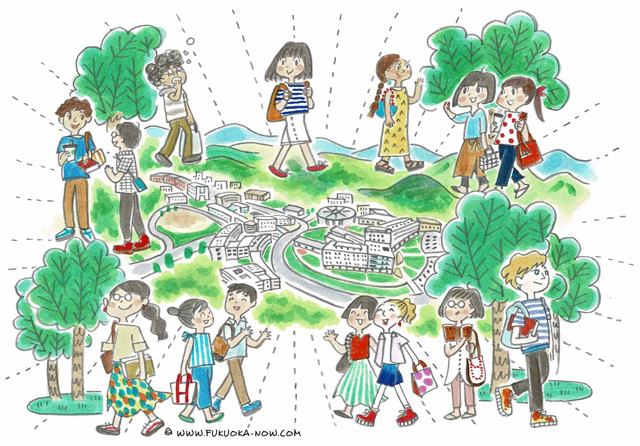Hakata Culture vol.162
Kyushu University's Ito Campus: An Integral Part of the Community

Last year, the City Planning Institute of Japan presented its Urban Design Award to Kyushu University‘s Ito Campus, a 272 ha site stretching from Motooka in Fukuoka City’s Nishi Ward into Itoshima City. The merger and relocation of facilities from the university’s Hakozaki and Ropponmatsu campuses to the Ito Campus has resulted in the creation of a new hub for academic research in the city. The relocation was finally completed in 2018, 17 years after the formulation of a campus master plan in 2001.
Where Ito Campus sits used to be rolling green hills, and the name “Ito” comes from the ancient Kingdom of Ito which used to be located here. Keeping in mind the natural surroundings and historical context, the university’s plan aimed to realize a campus that would seamlessly coexist with the local community and environment.
The buildings were built to follow the contour of the land to avoid ruining the existing landscape as much as possible. Efforts were made to protect the local ecosystem, including the groundwater that feeds local homes and farms, and the university continues to survey and monitor its impact on the environment. A group of students, faculty and staff have undertaken a project to rejuvenate the local satoyama (areas where human habitations coexist with nature), as part of the university’s research activities.
What’s more, there are many ruins and buried cultural properties on the campus. Although the original structures have disappeared long ago, the university has made every effort to preserve and restore these sites, which are open to the public. Several excavated artifacts are on display at the Ishigahara Tumulus Exhibition and Observation Room, which affords a panoramic view of the entire campus. Come experience the intersection of ancient history and state-of-the-art research facilities on this modern tree-filled campus.
地域と共生する九州大学伊都キャンパス
福岡市西区元岡から糸島市にかけての272haの敷地に広がる九州大学伊都キャンパスが、昨年の日本都市計画学会で都市設計賞を受賞しました。伊都キャンパスは福岡市内にあった箱崎キャンパスと六本松キャンパスを統合し、新たな学術研究都市の拠点として誕生したものです。2001年のマスタープラン策定から17年の歳月をかけて、2018年にすべての移転が完了しました。
伊都キャンパスが計画された場所はもともと自然がとても豊かな地域で、緑の丘陵地帯が広がっていました。またキャンパス名になっている「伊都」は、この地にあったとされる古代国家「伊都国」に由来しており、古くからの歴史ある地域でもあります。新キャンパスの計画ではこうした点に考慮して、地域社会や地域環境と共生する大学キャンパスを目指してきました。
建物などの配置はもとの地形を活かし、景観や環境をできるだけ壊さないように配慮されています。地域の生態系を守り、周辺住民の生活・農業用水となっている地下水の保全も考えられ、現在も継続的に環境の調査や監視が行われています。学生や教職員が参加して周囲の里山を再生させる取り組みも行われています。こうした活動は大学の研究の一環でもあるのです。
また、キャンパス内にはたくさんの遺跡や埋蔵文化財が存在します。残念ながらキャンパスの造成で消えてしまった遺跡もありますが、できる限り現状保存や復元整備をして公開されています。キャンパス全体を見渡せる石ヶ原古墳跡展望展示室には出土品も展示されています。最先端の研究施設や現代的な建物が建ち並ぶキャンパスで、古代からの歴史を感じるのは不思議な体験です。

